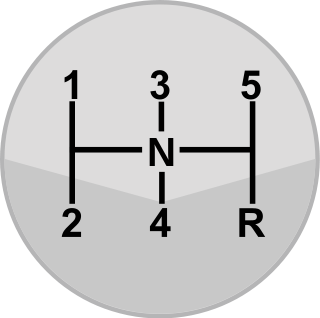
The Lunar Roving Vehicle (LRV) is a battery-powered four-wheeled rover used on the Moon in the last three missions of the American Apollo program during 1971 and 1972. It is popularly called the Moon buggy, a play on the term dune buggy.

A game controller, gaming controller, or simply controller, is an input device used with video games or entertainment systems to provide input to a video game, typically to control an object or character in the game. Before the seventh generation of video game consoles, plugging in a controller into one of a console's controller ports were the primary means of using a game controller, although since then they have been replaced by wireless controllers, which do not require controller ports on the console but are battery-powered. USB game controllers could also be connected to a computer with a USB port. Input devices that have been classified as game controllers include keyboards, mouses, gamepads, joysticks, etc. Special purpose devices, such as steering wheels for driving games and light guns for shooting games, are also game controllers.

Four-wheel drive, also called 4x4 or 4WD, refers to a two-axled vehicle drivetrain capable of providing torque to all of its wheels simultaneously. It may be full-time or on-demand, and is typically linked via a transfer case providing an additional output drive shaft and, in many instances, additional gear ranges.

The Toyota Sera is a 3-door 2+2 hatchback coupe manufactured and marketed by Toyota from 1990 to 1996.

The Toyota FJ Cruiser is a retro style, mid-size SUV. Introduced as a concept car at the January 2003 North American International Auto Show, the FJ Cruiser was approved for production after positive consumer response and debuted at the January 2005 North American International Auto Show in final production form.

The i-unit is an ultra-compact single seater four wheeled Toyota concept car. It debuted at the World Expo 2005, held in Aichi Prefecture, Japan. The vehicle is a cross between a microcar, a motorcycle, and a vehicular exoskeleton. The goal of Toyota is to provide a personal mobility, which can be used on roads but also does not hinder interaction with pedestrians. For this the i-unit has two possible setups. First, there is an upright low speed setup, where the rider has a higher position and can have conversations face-to-face with pedestrians and can move among people. This upright position can be transformed while driving to a low position, where the rider sits much lower and more reclined. This high speed setup has a much lower center of gravity and is for driving at higher speeds.

A gear stick, gear lever, gearshift or shifter, more formally known as a transmission lever, is a metal lever attached to the transmission of an automobile. The term gear stick mostly refers to the shift lever of a manual transmission, while in an automatic transmission, a similar lever is known as a gear selector. A gear stick will normally be used to change gear whilst depressing the clutch pedal with the left foot to disengage the engine from the drivetrain and wheels. Automatic transmission vehicles, including hydraulic automatic transmissions, automated manual and older semi-automatic transmissions, like VW Autostick, and those with continuously variable transmissions, do not require a physical clutch pedal.
Hybrid vehicle drive trains transmit power to the driving wheels for hybrid vehicles. A hybrid vehicle has multiple forms of motive power.

The Toyota iQ is an ultra-compact, front transverse engine, front-wheel-drive city car manufactured by Toyota and marketed in a single generation for Japan (2008–2016); Europe (2008–2015); and North America (2012–2015), where it was marketed as the Scion iQ. A rebadged variant was marketed in Europe as the Aston Martin Cygnet (2009–2013).

The Toyota Mark X ZiO is a mid-size MPV manufactured by Toyota from 2007 to 2013. It replaces the Mark II Blit and Opa, and was exclusive to Toyota Japan dealerships Toyopet Store, sold alongside the Mark X sedan from September 2007.
Toyota Concept Vehicles produced between 1980 and 1989 include:

A motorized wheelchair, powerchair, electric wheelchair or electric-powered wheelchair (EPW) is a wheelchair that is propelled by means of an electric motor rather than manual power. Motorized wheelchairs are useful for those unable to propel a manual wheelchair or who may need to use a wheelchair for distances or over terrain which would be fatiguing in a manual wheelchair. They may also be used not just by people with 'traditional' mobility impairments, but also by people with cardiovascular and fatigue-based conditions.

The Honda U3-X is an experimental self-balancing one-wheeled personal transporter shown in 2009.

The CityCar or MIT CityCar is an urban all-electric concept car designed at the Massachusetts Institute of Technology Media Lab. The project was conceived by William J. Mitchell and his Smart Cities Research Group. It is now led by Kent Larson, Director of the Changing Places Research Group at the Media Lab. The project came into reality in 2003 under the support of General Motors. Time magazine choose the CityCar to be one of the "Best Inventions of 2007".
This is a list of concept vehicles from Toyota for the years 2010–2019.

Electric vehicle warning sounds are sounds designed to alert pedestrians to the presence of electric drive vehicles such as hybrid electric vehicles (HEVs), plug-in hybrid electric vehicles (PHEVs), and battery electric vehicles (BEVs) travelling at low speeds. Warning sound devices were deemed necessary by some government regulators because vehicles operating in all-electric mode produce less noise than traditional combustion engine vehicles and can make it more difficult for pedestrians and cyclists to be aware of their presence. Warning sounds may be driver triggered or automatic at low speeds; in type, they vary from clearly artificial to those that mimic engine sounds and those of tires moving over gravel.

The Type 73 Medium Truck is an all-terrain four-wheel drive (4x4) truck of the Japan Ground Self-Defense Force known as the 1 1/2 Ton Truck.














